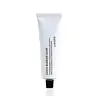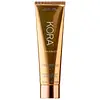What's inside
What's inside
 Key Ingredients
Key Ingredients

 Benefits
Benefits

 Concerns
Concerns

 Ingredients Side-by-side
Ingredients Side-by-side

Aloe Barbadensis Leaf Water
MaskingPrunus Armeniaca Kernel Oil
MaskingSimmondsia Chinensis Seed Oil
EmollientRosa Centifolia Leaf Cell Extract
AntioxidantGlycerin
HumectantCetearyl Olivate
Sorbitan Olivate
EmulsifyingPentylene Glycol
Skin ConditioningRosa Canina Fruit Oil
EmollientLactobacillus Ferment
Skin ConditioningSucrose Stearate
EmollientWater
Skin ConditioningLactobacillus
Skin ConditioningSodium Levulinate
Skin ConditioningPelvetia Canaliculata Extract
Skin ProtectingCyamopsis Tetragonoloba Gum
Emulsion StabilisingTocopherol
AntioxidantCocos Nucifera Fruit Extract
EmollientSodium Anisate
AntimicrobialHelianthus Annuus Seed Oil
EmollientLactic Acid
BufferingLavandula Angustifolia Flower Oil
MaskingLinalool
PerfumingAloe Barbadensis Leaf Water, Prunus Armeniaca Kernel Oil, Simmondsia Chinensis Seed Oil, Rosa Centifolia Leaf Cell Extract, Glycerin, Cetearyl Olivate, Sorbitan Olivate, Pentylene Glycol, Rosa Canina Fruit Oil, Lactobacillus Ferment, Sucrose Stearate, Water, Lactobacillus, Sodium Levulinate, Pelvetia Canaliculata Extract, Cyamopsis Tetragonoloba Gum, Tocopherol, Cocos Nucifera Fruit Extract, Sodium Anisate, Helianthus Annuus Seed Oil, Lactic Acid, Lavandula Angustifolia Flower Oil, Linalool
Aloe Barbadensis Leaf Juice
Skin ConditioningPumice
AbrasiveGlycerin
HumectantRosa Canina Seed Powder
AbrasiveLactobacillus Ferment
Skin ConditioningWater
Skin ConditioningCamellia Sinensis Leaf Powder
ExfoliatingBambusa Arundinacea Stem Extract
Skin ConditioningOryza Sativa Extract
AbsorbentMorinda Citrifolia Seed Powder
Skin ConditioningLactobacillus
Skin ConditioningRosa Canina Fruit Oil
EmollientSodium Levulinate
Skin ConditioningSclerotium Gum
Emulsion StabilisingPopulus Tremuloides Bark Extract
AntiseborrhoeicCarica Papaya Fruit Extract
Skin ConditioningCetearyl Alcohol
EmollientSodium Anisate
AntimicrobialPotassium Sorbate
PreservativeCurcuma Longa Root Extract
MaskingCocos Nucifera Fruit Extract
EmollientSodium Stearoyl Glutamate
CleansingHelianthus Annuus Seed Wax
Skin ConditioningMentha Piperita Flower/Leaf/Stem Oil
Skin ConditioningLactic Acid
BufferingLavandula Angustifolia Oil
MaskingCitrus Limon Peel Oil
MaskingMaltodextrin
AbsorbentCetearyl Glucoside
EmulsifyingCarrageenan
Sodium Phytate
Cananga Odorata Flower Oil
MaskingJuniperus Virginiana Oil
MaskingGlucose
HumectantLeuconostoc Ferment Filtrate
AntimicrobialTocopherol
AntioxidantSoybean Peroxidase
AntioxidantSuperoxide Dismutase
AntioxidantAscorbyl Palmitate
AntioxidantAlcohol
AntimicrobialLimonene
PerfumingLinalool
PerfumingAloe Barbadensis Leaf Juice, Pumice, Glycerin, Rosa Canina Seed Powder, Lactobacillus Ferment, Water, Camellia Sinensis Leaf Powder, Bambusa Arundinacea Stem Extract, Oryza Sativa Extract, Morinda Citrifolia Seed Powder, Lactobacillus, Rosa Canina Fruit Oil, Sodium Levulinate, Sclerotium Gum, Populus Tremuloides Bark Extract, Carica Papaya Fruit Extract, Cetearyl Alcohol, Sodium Anisate, Potassium Sorbate, Curcuma Longa Root Extract, Cocos Nucifera Fruit Extract, Sodium Stearoyl Glutamate, Helianthus Annuus Seed Wax, Mentha Piperita Flower/Leaf/Stem Oil, Lactic Acid, Lavandula Angustifolia Oil, Citrus Limon Peel Oil, Maltodextrin, Cetearyl Glucoside, Carrageenan, Sodium Phytate, Cananga Odorata Flower Oil, Juniperus Virginiana Oil, Glucose, Leuconostoc Ferment Filtrate, Tocopherol, Soybean Peroxidase, Superoxide Dismutase, Ascorbyl Palmitate, Alcohol, Limonene, Linalool
Ingredients Explained
These ingredients are found in both products.
Ingredients higher up in an ingredient list are typically present in a larger amount.
Cocos Nucifera Fruit Extract comes from the meat of the coconut fruit. It is an emollient and skin conditioner with antioxidant properties.
Coconut fruit is naturally rich in amino acids, sugars, and nutrients including Vitamin C and small amounts of vitamin B. Malic acid can also be found in coconut fruit extract.
Glycerin is already naturally found in your skin. It helps moisturize and protect your skin.
A study from 2016 found glycerin to be more effective as a humectant than AHAs and hyaluronic acid.
As a humectant, it helps the skin stay hydrated by pulling moisture to your skin. The low molecular weight of glycerin allows it to pull moisture into the deeper layers of your skin.
Hydrated skin improves your skin barrier; Your skin barrier helps protect against irritants and bacteria.
Glycerin has also been found to have antimicrobial and antiviral properties. Due to these properties, glycerin is often used in wound and burn treatments.
In cosmetics, glycerin is usually derived from plants such as soybean or palm. However, it can also be sourced from animals, such as tallow or animal fat.
This ingredient is organic, colorless, odorless, and non-toxic.
Glycerin is the name for this ingredient in American English. British English uses Glycerol/Glycerine.
Learn more about GlycerinLactic Acid is another well-loved alpha hydroxy acid (AHA). It is gentler than glycolic acid but still highly effective.
Its main role is to exfoliate the surface of the skin by loosening the “glue” that holds dead skin cells together. Shedding those old cells leads to smoother, softer, and more even-toned skin.
Because lactic acid molecules are larger than glycolic acid, they don’t penetrate as deeply. This means they’re less likely to sting or irritate, making it a great choice for beginners or those with sensitive skin.
Like glycolic acid, it can:
Lactic acid also acts as a humectant (like hyaluronic acid). It can draw water into the skin to improve hydration and also plays a role in the skin's natural moisturizing factor (NMF) in the form of sodium lactate.
Studies show it can boost ceramide production to strengthen the skin barrier and even help balance the skin’s microbiome.
To get results, choose products with a pH between 3-4.
Lower strengths (5-12%) focus on surface exfoliation; higher strengths (12% and up) can reach deeper in the dermis (deeper, supportive layer) to improve skin texture and firmness over time.
Though it was originally derived from milk, most modern lactic acid used in skincare is vegan. It is made through non-dairy fermentation to create a bio-identical and stable form suitable for all formulations.
When lactic acid shows up near the end of an ingredient list, it usually means the brand added just a tiny amount to adjust the product’s pH.
Legend has it that Cleopatra used to bathe in sour milk to help reduce wrinkles.
Lactic acid is truly a gentle multitasker: it exfoliates, hydrates, strengthens, and brightens. It's a great ingredient for giving your skin a smooth, glowing, and healthy look without the harshness of stronger acids.
Read more about some other popular AHA's here:
Learn more about Lactic AcidLactobacillus is a type of bacteria with skin conditioning properties. This ingredient has antibacterial and antifungal properties (that's why we can eat fermented foods).
Learn more about the benefits of lactobacillus ferment here.
Fun Fact: Lactobacillus is used to create wine, yogurt, cheese, sauerkraut, pickles, beer, cider, kimchi, cocoa, kefir.
Learn more about LactobacillusLactobacillus Ferment is created by fermenting the Lactobacillus bacteria. It helps keep our skin's natural barrier and microbiome healthy.
Studies show lactobacillus ferment to be effective at repairing the skin barrier. Having a healthy skin barrier helps keep your skin healthy and hydrated. It also protects against bad bacteria.
As a probiotic/prebiotic/postbiotic, Lactobacillus ferment can help regular our natural biome. In fact, one study found a lack of diversity in our natural skin biome can trigger acne.
Learn more about Lactobacillus FermentLinalool is a fragrance and helps add scent to products. It's derived from common plants such as cinnamon, mint, citrus, and lavender.
Like Limonene, this ingredient oxidizes when exposed to air. Oxidized linalool can cause allergies and skin sensitivity.
This ingredient has a scent that is floral, spicy tropical, and citrus-like.
Learn more about LinaloolRosehip Oil is a non-fragrant plant oil. Rosehips are a fruit from a rose bush and are edible. This oil has skin conditioning and hydrating properties.
Rosehip contains Vitamin C, Vitamin E, fatty acids and linolenic acids. These nourish your skin barrier. Having hydrated skin may help reduce the appearance of fine-lines and wrinkles.
Another great component of Rosehip Oil is Vitamin A, or retinol. Vitamin A encourages your skin to create more collagen.
Rosehip oil may help with reducing pigmentation. The lycopene and beta-carotene have skin-lightening properties. However, more studies are needed to confirm this.
Learn more about Rosa Canina Fruit OilSodium Anisate comes from fennel. It is used as a preservative and to add flavoring.
Sodium Anisate has antimicrobial properties.
Sodium levulinate is the a sodium salt of Levulinic Acid. If dissolved in an aqueous solution, the two ingredients become identical.
It is a skin conditioning agent, meaning it helps soften and hydrate your skin.
According to Cosmetic Ingredient Review, the highest amounts of sodium levulinate are found in mouthwashes at 0.62%.
Learn more about Sodium LevulinateTocopherol (also known as Vitamin E) is a common antioxidant used to help protect the skin from free-radicals and strengthen the skin barrier. It's also fat soluble - this means our skin is great at absorbing it.
Vitamin E also helps keep your natural skin lipids healthy. Your lipid skin barrier naturally consists of lipids, ceramides, and fatty acids. Vitamin E offers extra protection for your skin’s lipid barrier, keeping your skin healthy and nourished.
Another benefit is a bit of UV protection. Vitamin E helps reduce the damage caused by UVB rays. (It should not replace your sunscreen). Combining it with Vitamin C can decrease sunburned cells and hyperpigmentation after UV exposure.
You might have noticed Vitamin E + C often paired together. This is because it is great at stabilizing Vitamin C. Using the two together helps increase the effectiveness of both ingredients.
There are often claims that Vitamin E can reduce/prevent scarring, but these claims haven't been confirmed by scientific research.
Learn more about TocopherolWater. It's the most common cosmetic ingredient of all. You'll usually see it at the top of ingredient lists, meaning that it makes up the largest part of the product.
So why is it so popular? Water most often acts as a solvent - this means that it helps dissolve other ingredients into the formulation.
You'll also recognize water as that liquid we all need to stay alive. If you see this, drink a glass of water. Stay hydrated!
Learn more about Water